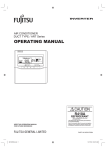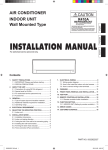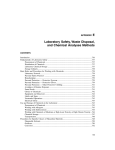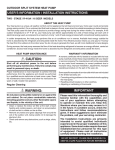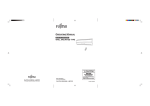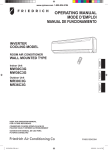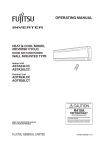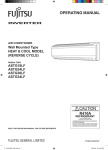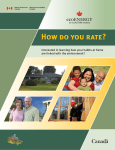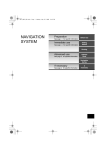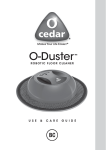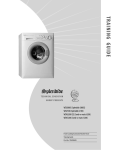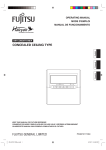Download Duct Type - Fujitsu General
Transcript
AIR CONDITIONER Duct Type OPERATING MANUAL KEEP THIS MANUAL FOR FUTURE REFERENCE P/N9374379460 CONTENTS SAFETY PRECAUTIONS........................................ 1 FEATURES AND FUNCTIONS ............................... 3 NAME OF PARTS ................................................... 4 PREPARATORY OPERATION ................................ 5 OPERATION ........................................................... 6 TIMER FUNCTIONS ............................................... 8 ON/OFF TIMER ....................................................... 8 WEEKLY TIMER ...................................................... 9 TEMPERATURE SET BACK TIMER ......................11 ECONOMY OPERATION ...................................... 12 CLEANING AND CARE ......................................... 12 TROUBLESHOOTING .......................................... 13 OPERATING TIPS................................................. 14 SELF-DIAGNOSIS ................................................ 16 TEMPERATURE AND HUMIDITY RANGE ........... 16 SAFETY PRECAUTIONS L Before using the appliance, read these “SAFETY PRECAUTIONS” thoroughly and operate in the correct way. L The instructions in this section all relate to safety; be sure to maintain safe operating conditions. L “DANGER”, “WARNING” and “CAUTION” have the following meanings in these instructions: This mark indicates procedures which, if improperly performed, might lead to the death WARNING! or serious injury of the user or service personnel. This mark indicates procedures which, if improperly performed, might possibly result in personal harm to the user, or damage to property. CAUTION! DANGER! CAUTION! En-1 Do not attempt to install this air conditioner by yourself. This unit contains no user-serviceable parts. Always consult authorized service personnel for repairs. L When moving, consult authorized service personnel for disconnection and installation of the air conditioner. L Do not become excessively chilled by staying for many hours in the direct cooling airflow. L Do not insert fingers or objects into the outlet port or intake grilles. L Do not start and stop air conditioner operation by turning off the electrical breaker and so on. L In the event of a malfunction (burning smell, etc.), immediately stop operation, turn off the electrical breaker, and consult authorized service personnel. L In the event of refrigerant leakage , be sure to keep away from fire or any flammables. (consult authorized service personnel) L L Provide occasional ventilation during use. Do not direct air flow at fireplaces or heating apparatus. L Do not climb on, or place objects on, the air conditioner. L Do not hang objects from the indoor unit. L Do not set flower vases or water containers on top of air conditioners. L Do not expose the air conditioner directly to water. L Do not operate the air conditioner with a wet hand. An electric shock may result. L Do not touch the switches with sharp objects. L Turn off power source when not using the unit for extended periods. L Always turn off the electrical breaker whenever cleaning the air conditioner or changing the air filter. L Connection valves become hot during Heating; handle with care. L Check the condition of the installation stand for damage. L Do not place animals or plants in the direct path of the air flow. L When restarting after a long period of disuse in the winter, turn the power switch on at least 12 hours before starting the unit. L Do not drink the water drained from the air conditioner. L Do not use the air conditioner for other purposes. In order to avoid any quality deterioration, do not use the unit for cooling precision instruments, food, planets, animals or works of art. L Do not apply any heavy pressure to radiator fins. L Operate only with air filters installed. L Do not block or cover the intake grille and outlet port. L Ensure that any electronic equipment is at least 1m away from either the indoor or outdoor units. L Avoid installing the air conditioner near a fireplace or other heating apparatus. L When installing the indoor and outdoor units, take precautions to prevent access by infants. L Do not use inflammable gases near the air conditioner. L Install the drain hose so that it drains water properly. L L CAUTION! L To install a unit that uses R410A refrigerant, use dedicated tools and piping materials that have been manufactured specifically for R410A use. Because the pressure of R410A refrigerant is approximately 1.6 times higher than the R22, failure to use dedicated piping material or improper installation can cause rupture or injury. Furthermore, it can cause serious accidents such as water leakage, electric shock, or fire. L This appliance is not intended for use by persons (including children) with reduced physical, sensory or mental capabilities, or lack of experience and knowledge, unless they have been given supervision or instruction concerning use of the appliance by a person responsible for their safety. Children should be supervised to ensure that they do not play with the appliance. L When the thunder sounds and the lightning malfunction strike, do not touch the outdoor unit. If the lightning strike, it can cause malfunction or electric shock. L Do not place other electric appliance or furniture under the outdoor unit and under the outlet port of indoor unit. The water may drop and can cause the taint damage or fault. L Keep clean and do not place the things around the outdoor unit. If covered with fallen leaves, it can cause the fault by the small animals or insects coming into and touch the internal electric parts. L Do not stand on unstable steps when operating or cleaning the air conditioner. It may overturn and can cause the injury. L Does not install the indoor unit and the outdoor unit in the following areas: Area with high salt content, such as at the seaside. It will deteriorate metal parts, causing the parts to fail or the unit to leak water. Area filled with mineral oil or containing a large amount of splashed oil or steam, such as a kitchen. It will deteriorate plastic parts, causing the parts to fail or the unit to leak water. Area that generates substances that adversely affect the equipment, such as sulfuric gas, chlorine gas, acid, or alkali. It will cause the copper pipes and brazed joints to corrode, which can cause refrigerant leakage. Area containing equipment that generates electromagnetic interference. It will cause the control system to malfunction, preventing the unit from operating normally. Area that can cause combustible gas to leak, contains suspended carbon fibers or flammable dust, or volatile inflammables such as paint thinner or gasoline. If gas leaks and settles around the unit, it can cause a fire. Area where small animals may live. It may cause failure, smoke or fire if small animals enter and touch internal electrical parts. Area where animals may urinate on the unit or ammonia may be generated. L L L L L L L En-2 FEATURES AND FUNCTIONS N Energy saving and N Remote controller Comfortable function INVERTER At the start of operation, large amount of power is used to bring the room quickly to the desired temperature. Afterwards, the unit automatically switches to a low power setting for economic and comfortable operation. ECONOMY OPERATION When ECONOMY operation mode is operated, the room temperature will be little higher than the set-temp under cooling mode and lower than set-temp under heating mode. Therefore, the ECONOMY mode is able to save more energy than other normal mode. AUTO CHANGEOVER The operation mode (cooling, dry, heating) is switched automatically to maintain the set temperature, and the temperature is kept constant at all times. WIRED REMOTE CONTROLLER The wired remote controller allows convenient control of indoor unit operation. WIRELESS REMOTE CONTROLLER (OPTION) The optional wireless remote controller can be used.When you use remote controller, there are following different points as compared with using wired remote controller. [ The additional function for wireless ones ] • SLEEP • TIMER And you can use both wireless and wired remote controller simultaneously. (But function is limited.) [ The restricted functions for wired ones ] • Weekly timer • Temperature set back timer N Convenient function WEEKLY TIMER Use this timer function to set operating times for each day of the week. Use the DAY OFF setting to switch off timed operation for a selected day in the coming week. Because all days can be set together, the weekly timer can be used to repeat the timer settings for all of the days. TEMPERATURE SET BACK TIMER Use this timer function to change the set temperature in the operation times set for each day of the week. This can be used together with other timer settings. En-3 NAME OF PARTS Remote controller START/STOP Button SET TEMP. (Temperature) Button MODE Button FAN Button ECONOMY Button TIMER MODE (CLOCK ADJUST) Button DAY (DAY OFF) Button SET BACK Button SET TIME ( < > ) Button TIMER DELETE Button TIMER SET Button Vertical Airflow Direction and Swing Button*1 Horizontal Airflow Direction and Swing Button*2 MAINTENANCE(FILTER RESET) Button#1 Operation Lamp Timer and Clock Display Operation Mode Display Fan Speed Display Operation Lock Display Temperature Display Function Display Defrost Display Thermo Sensor Display ECONOMY Display Vertical Swing Display*3 Filter Display#1 *1~3 These functions cannot be used. #1 (Please also see the operating manual of the option when using it with options, etc.) Can be used if set correctly during installation. Please consult authorized serviceman when using this function. En-4 PREPARATORY OPERATION Set the current day and time 1 2 Press the TIMER MODE (CLOCK ADJUST) button for 2 seconds or more. The time display on the remote controller will flash. 3 Press the DAY button and select the current day. A appears around the selected day. SU MO TU Press the SET TIME (< >) buttons to set the current time. Press repeatedly to adjust the current time in 1-minute increments. Press and hold to adjust the current time in 10-minute increments. SU MO TU WE TH FR SA ex. Monday 23:00 4 SET BACK SU MO TU WE TH FR SA 5 Press again to end. En-5 WE Press the SET BACK button to switch between the 12- and 24-hour time displays. SU MO TU WE TH FR SA TH FR SA OPERATION Instructions relating to heating (*) are applicable only to “HEAT & COOL MODEL” (Reverse Cycle). To start/stop operation Press the START/STOP button. Operation lamp Air conditioner ON: Lit brightly Air conditioner OFF: Not lit To set the operation mode LOperation mode setting Press the MODE button to set the operation mode. If DRY is selected, the fan speed will be set to AUTO. AUTO LRoom temperature setting COOL DRY FAN * HEAT Press the SET TEMP. buttons to set the room temperature. Temperature setting range AUTO ............................................... 18 to 30 °C COOL/DRY ...................................... 18 to 30 °C * HEAT................................................ 16 to 30 °C Lower Rise LFan speed setting Press the FAN button to set the fan speed. AUTO HIGH MED LOW ECONOMY OPERATION Press the ECONOMY button to start or stop ECONOMY OPERATION. For details on the function, refer to page 12. En-6 OPERATION Room temperature sensor selection • This function is locked at the factory. In order to detect the room temperature correctly, consult authorized service personnel when using this function. Indoor unit Press the ECONOMY button for more than 2 seconds to select whether the room temperature is detected at the indoor unit or the remote controller. When the thermo sensor display appears, the room temperature is detected at the remote controller. NOTES • If this function is locked, the location where the room temperature is detected cannot be changed and the when the ECONOMY button is pushed for 2 seconds or more. Child lock function Press the DAY (DAY OFF) button and TIMER SET button simultaneously for 2 seconds or more to activate the child lock function and lock all of the buttons on the remote controller except the START/STOP button, SET TEMP. buttons, MODE button, and FAN button. Press the buttons again for 2 seconds or more to deactivate the child lock function. mark When the child lock function is activated, the appears.If any button is pressed during the child lock, the CL display flashes. En-7 mark flashes TIMER FUNCTIONS OFF timer (See page 8.) Use this timer function to stop air conditioner operation. The timer operates and air conditioner operation stops after the set time has passed. The timer can be set up to 24 hours in advance. ON timer (See page 8.) Use this timer function to start air conditioner operation. The timer operates and air conditioner operation starts after the set time has passed. The timer can be set up to 24 hours in advance. WEEKLY timer (See page 9.) Use this timer function to set operating times for each day of the week. Use the DAY OFF setting to switch off timed operation for a selected day in the coming week. Because all days can be set together, the weekly timer can be used to repeat the timer settings for all of the days. Temperature SET BACK timer (See page 11.) Use this timer function to change the set temperature in the operation times set for each day of the week. This can be used together with other timer settings. ON/OFF TIMER To set the ON/OFF timer 1 Press the TIMER MODE button to select the ON timer or OFF timer. 2 SU MO TU WE TH FR SA From 1 to 24 hours No display NON STOP OFF TIMER ON TIMER WEEKLY TIMER ex. OFF timer set for 6 hours Press the SET TIME (< >) buttons to set the time. After the time is set, the timer will start automatically. The amount of time until the OFF timer operates that is displayed on the timer display decreases as time passes. LTo cancel • Press the TIMER DELETE button to cancel the timer mode. • The timer mode can also be canceled by changing the timer mode using the TIMER MODE button. En-8 WEEKLY TIMER Weekly timer setting 1 2 Press the TIMER SET button for 2 seconds or more. Press the TIMER MODE button to select the weekly timer. 3 LDay of the week setting ALL SU MO TU WE TH FR SA 2 1 Press the DAY button to select the day of the week, and then press the TIMER SET button to confirm the setting. For ALL, all of the days can be set together when a appears around each day. 4 LTime setting When the operating time is set, the mark appears. 1 ON-1 OFF-1 3 2 ON-2 OFF-2 ex. The timer is set for 7:00-18:00. Press the SET TIME (< >) buttons to set the time, and then press the TIMER SET button to confirm the setting and proceed to the next ON or OFF time setting. Up to 2 times ON and OFF times can be set per day. Press the DAY button to complete the time setting and return to the day of the week setting. 5 LTo delete the operating time If the TIMER DELETE button is pressed dur- 3 4 ing steps or , the operating time for the selected day will be deleted. If all the days are selected, the operating times for all of the days will be deleted. 3 4 Repeat steps and . To complete the weekly timer settings, press the TIMER SET button for 2 seconds or more. NOTES • The operating time can be set in 30-minute increments only. • The OFF time can be carried over to the next day. • The ON timer and the OFF timer functions cannot be set using the weekly timer. Both an ON and OFF time must be set. En-9 WEEKLY TIMER WEEKLY timer operation LTo start LTo cancel When the weekly timer is selected, the timer starts automatically. • Press the TIMER DELETE button to cancel the timer mode. • The timer mode can also be canceled by changing the timer mode using the TIMER MODE button. ex. Operating time 7:00-18:00 The operating time for the current day is displayed. To set the DAY OFF (for a holiday) 1 2 3 4 During the weekly timer, press the TIMER SET button for 2 seconds or more to set the day. Select the day to set the DAY OFF. Press the DAY (DAY OFF) button for 2 seconds or more to set the DAY OFF. Press the TIMER SET button for 2 seconds or more to complete the DAY OFF setting. SU MO TU WE TH FR SA SU MO TU WE TH FR SA The mark flashes under a day of the week. L To cancel 3 6 9 12 15 18 21 3 6 9 12 15 18 21 ex. The DAY OFF is set for Monday. Follow the same procedures as those for setup. NOTES • The DAY OFF setting is only available for days for which weekly settings already exist. • If the operating time carries over to the next day (during a next day setting), the effective DAY OFF range will be set as shown below. LNormal LNext day setting DAY OFF ON OFF WEEKLY Preceding day ON DAY OFF ON OFF WEEKLY WEEKLY Setting day Next day Preceding day OFF ON OFF WEEKLY Setting day Next day • The DAY OFF setting can only be set 1 time. The DAY OFF setting is cancelled automatically after the set day has passed. En-10 TEMPERATURE SET BACK TIMER Temperature SET BACK timer setting 1 SET BACK 2 If there is no existing SET BACK temperature setting, “- -” will be displayed for the temperature. Press the TIMER SET button for 2 seconds or more. Press the SET BACK button to change to the SET BACK confirmation display. The SET BACK operating time and the set temperature will be displayed. 3 LDay setting 1 LOperating time setting 2 3 4 ex. When setting all days together Follow the same procedures to set the operating time as those for the weekly timer. The TIMER DELETE button is also used as described in the procedures for the weekly timer. 4 LTemperature setting Press the SET TEMP. buttons to set the temperature. (The temperature setting range is the same as the range for the operation mode.) ex. Operating time 15:00–22:00 SET BACK temperature Normal temperature ON 28°C OFF 24°C 24°C 5 3 4 Repeat steps and . Press the TIMER SET button for 2 seconds or more to complete the temperature SET BACK timer settings. Temperature SET BACK timer operation LTo cancel LTo start SET BACK 1 ex. Display during SET BACK timer operation (The operating time will not be displayed.) Press the SET BACK button. The SET BACK confirmation display appears for 5 seconds, and then the timer starts automatically. 2 Press the SET BACK button, and then press the TIMER DELETE button while the SET BACK confirmation display is displayed. Even if the SET BACK button is pressed again, the SET BACK timer will be cancelled. NOTES • • • • The SET BACK timer only changes the set temperature, it cannot be used to start or stop air conditioner operation. The SET BACK timer can be set to operate up to 2 times per day but only 1 temperature setting can be used. The SET BACK timer can be used together with the ON, OFF, and weekly timer functions. The SET BACK operating time is displayed only in the SET BACK confirmation display. (Refer to step 1 for the SET BACK confirmation display.) En-11 ECONOMY OPERATION Begin Air Conditioner operation before performing this procedure. To Use the ECONOMY Operation Press the ECONOMY button. The ECONOMY display will light. ECONOMY operation begins. To Stop the ECONOMY Operation Press the ECONOMY button again. The ECONOMY display will go out. Normal operation begins. About ECONOMY Operation At the maximum output, ECONOMY Operation is approximately 70% of normal air conditioner operation for cooling and heating. L If the room is not cooled (or heated) well during ECONOMY operation, select normal operation. L During the monitor period in the AUTO mode, the air conditioner operation will not change to ECONOMY operation even if ECONOMY operation is selected by pressing the ECONOMY operation button. L When ECONOMY operation mode is operated, the room temperature will be little higher than the set-temp under cooling mode and lower than set-temp under heating mode. Therefore, the ECONOMY mode is able to save more energy than other normal mode. L In case of multi-type air conditioner, the ECONOMY operation mode is only available for the set indoor unit. CLEANING AND CARE CAUTION! L Before cleaning the unit, be sure to stop the unit and disconnect the power supply. L Turn off the electrical breaker. L A fan operates at high speed inside the unit, and personal injury could result. L When used for extended periods, the unit may accumulate dust inside, reducing its performance. We recommend that the unit be inspected regularly, in addition to your own cleaning and care. For more information, consult authorized service personnel. L When cleaning the unit’s body, do not use water hotter than 40°C, harsh abrasive cleansers, or volatile agents like benzene or thinner. L Do not expose the unit body to liquid insecticides or hairsprays. L If the unit will not be operated for a period of 1 month or more, be sure to allow the inner parts of the unit to dry thoroughly, in advance, by operating the unit in fan mode for half a day. Cleaning the Air Filter L Remove the dust from the air filters by vacuuming or washing them. After washing, allow the air filters to dry thoroughly in an area protected from sunlight. L Dust can be cleaned from the air filter either with a vacuum cleaner, or by washing the filter in a solution of mild detergent and warm water. If you wash the filter, be sure to allow it to dry thoroughly in a shady place before reinstalling. L If dust is allowed to accumulate on the air filter, air flow will be reduced, lowering operating efficiency and increasing noise. Filter indicator Reset (Special setting) LCan be used if set correctly during installation. Please consult authorized serviceperson when using this function. • It lights on when it is time to clean the air filters. After turning the power on. Press the MAINTENANCE button for 2 seconds or more on the remote control. The filter display will disappear. En-12 TROUBLESHOOTING Instructions relating to heating (*) are applicable only to “HEAT & COOL MODEL” (Reverse Cycle). WARNING! In the event of a malfunction (burning smell, etc.), immediately stop operation, turn off the electrical breaker, and consult authorized service personnel. Merely turning off the unit’s power switch will not completely disconnect the unit from the power source. Always be sure to turn off the electrical breaker to ensure that power is completely off. Before requesting service, perform the following checks: Symptom NORMAL FUNCTION Doesn’t operate immediately: Noise is heard: Smells: Mist or steam are emitted: Airflow is weak or stops: Water is produced from the outdoor unit: thermo sensor display on the remote controller is flashing: CHECK ONCE Doesn’t operate at all: MORE Problem L If the unit is stopped and then immediately started again, the compressor will not operate for about 3 minutes, in order to prevent fuse blowouts. L Whenever the electrical breaker is turned off then on again, the protection circuit will operate for about 3 minutes, preventing unit operation during that period. — L During operation and immediately after stopping the unit, the sound of water flowing in the air conditioner’s piping may be heard. Also, noise may be particularly noticeable for about 2 to 3 minutes after starting operation (sound of coolant flowing). — *L During Heating operation, a sizzling sound may be heard occasionally. This sound is produced by the Automatic Defrosting operation. 14 L Some smell may be emitted from the indoor unit. This smell is the result of room smells (furniture, tobacco, etc.) which have been taken into the air conditioner. — L During Cooling or Dry operation, a thin mist may be seen emitted from the indoor unit. This results from the sudden Cooling of room air by the air emitted from the air conditioner, resulting in condensation and misting. — *LDuring Heating operation, the outdoor unit’s fan may stop, and steam may be seen rising from the unit. This is due to the Automatic Defrosting operation. 14 *LWhen Heating operation is started, fan speed is temporarily very low, to allow internal parts to warm up. * L During Heating operation, if the room temperature rises above the thermostat setting, the outdoor unit will stop, and the indoor unit will operate at very low fan speed. If you wish to warm the room further, set the thermostat to a higher setting. — *LDuring Heating operation, the unit will temporarily stop operation (between 4 and 15 minutes) as the Automatic Defrosting mode operates. During the Automatic Defrosting operation, will be shown on the remote controller display. 14 L The fan may operate at very low speed during Dry operation or when the unit is monitoring the room’s temperature. — L In the monitor AUTO operation, the fan will operate at very low speed. — *LDuring Heating operation, water may be produced from the outdoor unit due to the Automatic Defrosting operation. 14 L The room temperature sensor may be malfunctioning. Please consult authorized service personnel. Has the circuit breaker been turned off? L L Has there been a power failure? L Has a fuse blown out, or a circuit breaker been tripped? L Is the timer operating? Poor Cooling (or *Heating) performance: See Page — — 8 to 11 L L L L L Is the air filter dusty? Are the air conditioner’s intake grille or outlet port blocked? Did you adjust the room temperature settings (thermostat) correctly? Is there a window or door open? In the case of Cooling operation, is a window allowing bright sunlight to enter? (Close the curtains.) L In the case of Cooling operation, are there heating apparatus and computers inside the room, or are there too many people in the room? If the problem persists after performing these checks, or if you notice burning smells, stop operation immediately, turn off electric breaker, and consult with authorized service personnel. En-13 OPERATING TIPS Instructions relating to heating (*) are applicable only to “HEAT & COOL MODEL” (Reverse Cycle). *Heating Performance L This air conditioner operates on the heat-pump principle, absorbing heat from outdoor air and transferring that heat indoors. As a result, the operating performance is reduced as outdoor air temperature drops. If you feel that insufficient heating performance is being produced, we recommend you use this air conditioner in conjunction with another type of heating appliance. L Heat-pump air conditioners heat your entire room by recirculating air throughout the room, with the result that some time may be required after first starting the air conditioner until the room is heated. *When Indoor and Outdoor Temperature are High When both indoor and outdoor temperatures are high during use of the heating mode, the outdoor unit’s fan may stop at times to protect the unit. Low Ambient Cooling When the outdoor temperature drops, the outdoor unit’s fans may switch to Low Speed, or one of the fans may stop intermittently. Dual Remote Controllers (optional) An additional remote controller can be added up to the maximum of 2 remote controllers. Either remote controller can control the air conditioner. However, the timer functions cannot be used at the secondary unit. * Hot start The indoor unit prevents cold drafts when heating operation begins. The indoor unit fan will not operate until the heat exchanger reaches the set temperature. Group Control Fan speed: AUTO *Heating : The fan will operate at very low speed when the temperature of the air issued from the indoor unit is low. Cooling : As the room temperature approaches that of the set temperature, the fan speed becomes slower. Fan : The fan runs at the low fan speed. 1 remote controller can control up to 16 air conditioners. All of the air conditioners will be operated with the same settings. Group control cannot be used when using it by the multi type. *Microcomputer-controlled Automatic Defrosting L When using the Heating mode under conditions of low outdoor temperature and high humidity, frost may form on the outdoor unit, resulting in reduced operating performance. In order to prevent this kind of reduced performance, this unit is equipped with a Microcomputer-controlled Automatic Defrosting function. During the defrost cycle, the indoor fan will shutdown and will be displayed on the remote controller. It will take anywhere from 4 to 15 minutes before the air conditioner starts up again. L After heating operation stops, if frost forms on the outdoor unit, the unit will start Automatic Defrosting operation. At this time, the outdoor unit will automatically stop after operating for a few minutes. En-14 OPERATING TIPS Mode operation: AUTO COOLING MODEL L When the room temperature is 2 °C higher than the set temperature, the mode will switch between Cooling and Drying. L During the Drying mode operation, the fan will operate at a low speed for a gently cooling effect during which the fan may temporarily stop rotating. HEAT & COOL MODEL (Reverse Cycle) Auto changeover function L When AUTO CHANGEOVER is selected, the air conditioner selects the appropriate operation mode (Cooling or Heating) according to your room’s present temperature. L When AUTO CHANGEOVER is first selected, the fan will operate at a low speed for about a few minutes while the unit determines the current conditions of the room and selects the proper operation mode. If the difference between thermostat setting and actual room temperature is more than +2 °C m Cooling operation If the difference between thermostat setting and actual room temperature is within ±2 °C m Determined by outdoor temperature If the difference between thermostat setting and actual room temperature is more than –2 °C m Heating operation L When the room temperature is near the thermostat setting, the air conditioner will begin monitor operation. In the monitor operation mode, the fan will operate at a low speed. If the room temperature subsequently changes, the air conditioner will once again select the appropriate operation (Heating or Cooling) to adjust the temperature to the value set in the thermostat. L If the mode automatically selected by the unit is not what you wish, select one of the mode operation (HEAT, COOL, DRY, FAN). About Mode Operation * Heating: L Use to warm your room. L When Heating mode is selected, the air conditioner will operate at very low fan speed for about 3 to 5 minutes, after which it will switch to the selected fan setting. This period of time is provided to allow the indoor unit to warm up before beginning full operation. L When the outdoor temperature is very low, frost may form on the outdoor unit, and its performance may be reduced. In order to remove such frost, the unit will automatically enter the defrost cycle from time to time. During Automatic Defrosting operation, the heat operation will be interrupted. L After the start of heating operation, it takes sometime before the room gets warmer. Cooling: L Use to cool your room. Dry: L Use for gently cooling while dehumidifying your room. L You cannot heat the room during Dry mode. L During Dry mode, the unit will operate at low speed; in order to adjust room humidity, the indoor unit’s fan may stop from time to time. Also, the fan may operate at very low speed when adjusting room humidity. L The fan speed cannot be changed manually when Dry mode has been selected. Fan: L Use to circulate the air throughout your room. En-15 During Heating mode: Set the thermostat to a temperature setting that is higher than the current room temperature. The Heating mode will not operate if the thermostat is set lower than the actual room temperature. During Cooling/Dry mode: Set the thermostat to a temperature setting that is lower than the current room temperature. The Cooling and Dry modes will not operate if the thermostat is set higher than the actual room temperature (in Cooling mode, the fan alone will operate). During Fan mode: You can not use the unit to heat and cool your room. OPERATING TIPS AUTO Restart In Event of Power Interruption L If the power supply to the air conditioner is interrupted by a power failure, the air conditioner will restart automatically in the previously selected mode once the power is restored. L Use of other electrical appliances (electric shaver, etc.) or nearby use of a wireless radio transmitter may cause the air conditioner to malfunction. In this event, temporarily disconnect the power supply, reconnect it, and then use the remote controller to resume operation. Notice *L During use of the heating mode, the outdoor unit will occasionally commence the defrost operation for brief periods. During the defrosting operation, if the user sets the indoor unit for heating again, the defrosting mode will continue, and the heating operation will begin after completion of defrosting, with the result that some time may be required before warm air is emitted. *L During use of the heating mode, the top of the indoor unit may become warm, but this is due to the fact that coolant is circulated through the indoor unit even when it is stopped; it is not a malfunction. SELF-DIAGNOSIS When “Er” in Temperature Display is displayed, inspection of the air conditioning system is necessary. Please consult authorized service personnel. Unit number (usually “00”) Error code ex. Self-diagnosis check TEMPERATURE AND HUMIDITY RANGE Permissible ranges of temperature and humidity are as follows: Cooling / Dry Operation Heating Operation Outdoor temperature About –5°C to 46°C Indoor temperature About 18°C to 32°C Indoor humidity Below approximately 80%. If the air conditioner is used continuously for many hours, water may condense on the surface and drip. Outdoor temperature About –15°C to 24°C Indoor temperature About 16°C to 30°C If the unit is used under higher temperature conditions than those noted here, the automatic protection circuit may operate, interrupting the operation. If the unit is used under lower temperature conditions than those noted here, the heat exchanger may freeze, causing water leakage or other malfunction. L Do not use the air conditioner for any purpose other than room cooling/dry, room heating, or fan. En-16 NOTE NOTE




















